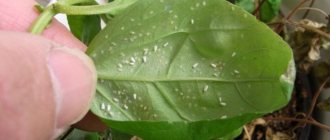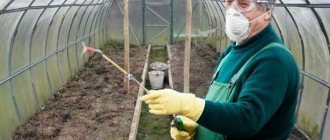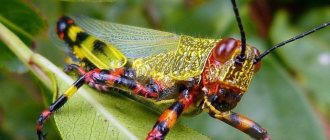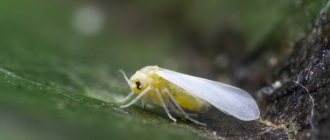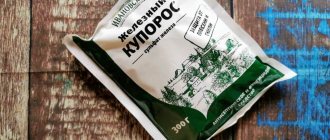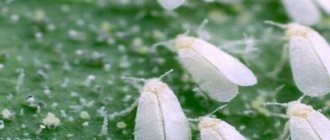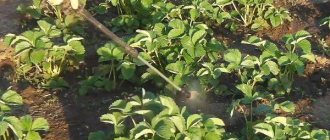What does a whitefly look like?
The whitefly, or aleurodida, is a flying insect from the family of small Homoptera. In total, there are about 1,500 species of this insect in nature, and in our latitudes only 20 of its varieties can be found.
The whitefly is somewhat reminiscent of a moth or moth with its wings folded in the shape of a house. Its size does not exceed 3 millimeters in length. The insect is completely white with a small yellow head. The wings are covered with fine white pollen.
How to detect whitefly
Before you think about how to get rid of this pest, you need to figure out how to detect it. After all, the sooner you notice traces of the appearance of whiteflies, the fewer consequences you can deal with.
Most often, whiteflies can be detected by the following signs:
- the plant has sharply slowed down its growth and development, the leaves turn yellow and curl
- white spots appeared on the leaves, which over time changed their color to dark - this is a fungal disease that often infects the plant with whitefly
- the inside of the plate is covered with a sticky coating
- the inner side is covered with small transparent scales, the remains of cocoons or insect eggs
If there is no visible damage, but neighboring plants are already affected, take a simple pencil and lightly hit each leaf. If the whitefly has already infested the plants, after such shocks you will see tiny white insects falling from the leaves on the ground.
Features of the insect
Whitefly butterflies live primarily on the leaves of fragrant plantings, although adults can settle on the inside and outside of the foliage of any plant in the garden. Parasites are considered omnivorous:
- they appear on cucumbers and tomatoes;
- can switch from vegetable to fruit crops;
- The larva adapts to feeding on beans, lettuce leaves, and flower plants.
Larvae (Whitefly larvae) represent the main risk group for the garden, since the younger generation needs nutrients. They are inactive, located on the back side of the foliage, since the place is safer there. They can be distinguished from adult individuals by their white-green color. Closer to the stage of transformation into a butterfly, whiteflies form a coating on the body that protects the body of the insect. In the future, a waxy layer may appear.
Important! At this stage of maturation, the butterfly becomes vulnerable. It is not affected by pesticides and insecticides due to the presence of a protective frame.
The main problem with the lesion is that the larvae can move between the leaves of different crops. Sometimes they migrate to branches or trunks. The whitefly in its larval stage secretes a sugary liquid that is of interest to ants.
The sticky layer attracts sooty fungi. The latter grow, covering the trees with a black coating. It prevents the plant from receiving sunlight. The foliage turns yellow within a month, the juices do not reach the roots, as a result of which the crop dies.
Where does the whitefly come from?
Whitefly can attack a plant in open ground, in a greenhouse, and even indoors. Even if the appearance of this insect in these specific conditions seems impossible, the whitefly can always find its way to the plant through:
- Soil. Most often, there are already eggs of this pest in the garden soil, and by placing the plant in greenhouse or indoor conditions, you can speed up the process of the appearance of the pest
- Window. Even mosquito nets will not stop the whitefly; its size allows it to climb into any hole
- Infected sprout. Cuttings shared by gardeners may already be infested with whitefly larvae.
The insect loves hot rooms where there is no good ventilation.
Whitefly eggs can wait a long time until the temperature and conditions they need are established, and only then turn into insects. At the same time, the whitefly cannot tolerate the cold and dies at temperatures below 10 degrees Celsius.
Description of the pest
There are at least 200 species of pests in the modern world. The pest is small in size, no more than 3 mm. There is a waxy coating on the wings that looks like flour. Externally they may resemble aphids. The pest is considered an insect with incomplete metamorphosis, but its development is quite complex.
Whitefly eggs and larvae
In particular, growth begins from the egg, from where the future insect receives nutrition by pressing the larva to the surface of the plant. During growth, a wax barrier forms around the larva, which tightly fits the surface of the leaf.
During its existence, the insect has the ability to lay up to 280 eggs once every 40 days. In appearance, the whitefly larva is yellow or green in color, and the cover is predominantly fleecy.
Whitefly larvae do not die when exposed to insecticides.
The greatest delicacies for the pest are fuchsias, balsams and begonias, lantana, pelargonium and passionflower. If he doesn’t have the opportunity to enjoy such indoor flowers, he happily switches to tomatoes and cucumbers, and other garden plants.
Prevention measures
It is easier to prevent the appearance of whiteflies than to later look for means to combat this pest. To avoid this threat, you must:
- fertilize the plant during planting and during growth and flowering
- do not plant plants close to each other
- do not fertilize the plant in the cold season
- monitor indoor air humidity
- provide fresh air access to the room, ventilate it
If, despite proper care of the plants, the pest still appears, it is necessary to select the optimal remedy for whiteflies.
Biological methods
Chemical preparations against whiteflies are gradually losing their relevance. Biological methods of control are being replaced. Examples:
- Placing encarsia pupae in greenhouses. The female parasite lays eggs in the bodies of whitefly larvae, which leads to death. Encarsia pupae are launched 2 weeks before planting. Macrolophus bug. Tobacco and greenhouse whiteflies are destroyed. These bugs are released before the active development of the pest. Against whiteflies, 1 insect per 1 m² is enough.
The colonization of greenhouses and greenhouses with entomophages is characterized by an efficiency of up to 99%. Biological enemies are especially useful for pests on tomatoes. Cucumbers contain hairs on the surface, which prevents entomophages.
On a note! Common natural enemies of whiteflies are the lacewing fly, ladybug, and ichneumon beetle.
Chemicals against whiteflies
When choosing effective pest control products, you need to pay attention to the safety of use in enclosed spaces. For example, insecticides are considered the most effective, but when treating plants, you cannot stay indoors for a long time.
The most common means are:
- Mospilan. Single spraying 0.05-0.06 g
- Actellik. One ampoule per liter of water to treat 5 square meters
- Confidor. 0.1 ml per liter of water and spray once
- Fufanon. 1.5 ml - one-time spraying
We prepare safe products with our own hands
The preparation of products according to folk recipes has already been discussed, so we need to focus on mechanical methods. Making a Glue Trap:
- Paint the pieces of plastic yellow. After drying, cover with entomological glue. Attach the lighting, hang the trap at the level of the tops of the plants.
In 1 hour, up to 80–85% of whiteflies will stick to this structure. At night, you can set another trap: place a light bulb painted yellow in a box, make holes at its level, and immerse a container of water in the bottom.
Mechanical action against whitefly
If treatment for whiteflies with chemicals is successful, then the effect can be enhanced by mechanical means. For example, the following are effective:
- fumigators against flies and mosquitoes placed at the base of the damaged plant
- handmade traps: small pieces of plywood painted with oil paint or wrapped with double-sided tape
Once the chemical attack has been applied, such methods can help eliminate any remaining insects.
Terms and rules for carrying out therapeutic measures
In spring and autumn, all measures to eliminate harmful insects are carried out. Greenhouses must be treated with disinfectants. Household chemicals should be used in the morning or evening.
- Sometimes copper sulfate is used. It helps to exterminate annoying insects before planting seedlings. The soil is moistened and dried.
- Bleach and potassium permanganate remove plaque left behind by parasites. The whitefly dies from chemical exposure, however, caustic substances can damage the crop and the plant itself.
- Polycarbonate should be used to treat soil and soil. The method is combined with smoke bombs, which repel insects using smell.
For prevention, after manipulations with the soil, the soil is impregnated with lime, dug up and filled with new solutions of copper dioxide.
Traditional methods of dealing with whitefly
The fight against whiteflies has been carried out by gardeners and flower growers for a very long time. Over the years, many effective recipes have appeared among the people that help get rid of this pest. The most popular of them:
Soap solution
Grate laundry soap or cut into thin shavings and dissolve in warm water in a ratio of 1:6. Apply foam from this solution to the plant and the top of the soil. Often one application is enough to ensure that the pest no longer exists. But if necessary, the procedure can be repeated after a week.
Dandelion infusion
100 grams of dandelions (with leaves and roots) are infused in a liter of water for several days. The solution must be filtered and sprayed on the plants with a spray bottle.
Tobacco infusion
All cigarettes from the pack are opened and filled with water for several days. The solution must be filtered and the plants sprayed with it from a spray bottle every few days.
Garlic infusion
Chop a few cloves, add 1 liter of water and leave for a day. Strain the solution and spray the plant with it from a spray bottle several times at intervals a week.
Yarrow infusion
Pour 100 g of yarrow into 1 liter of water and leave for several days. Strain the solution and spray the plant with it from a spray bottle several times at intervals a week.
It is known that the whitefly cannot tolerate low temperatures. Therefore, another popular method can be considered placing plants in a place where the air temperature does not currently exceed 10 degrees.
However, when using this method, it is necessary to take into account the susceptibility of the plant itself to low temperatures.
Photos of whiteflies may seem harmless, but the first impression in this case will be wrong. The damage this insect can cause is colossal. Therefore, it is necessary to detect the pest in time and quickly neutralize it.
Preventive measures
To prevent the pest from choosing a garden or greenhouse for its residence, feeding and reproduction, it is necessary:
- comply with agrotechnical plant planting standards;
- do not flood the plants too much;
- provide an opportunity to ventilate plants;
- maintain normal temperature conditions;
- feed the plants so that they are strong;
- dig up the soil for the winter;
- dispose of fallen leaves and tops after harvesting;
- do not destroy the natural enemies of the whitefly in nature: the lacewing and the ladybug.


